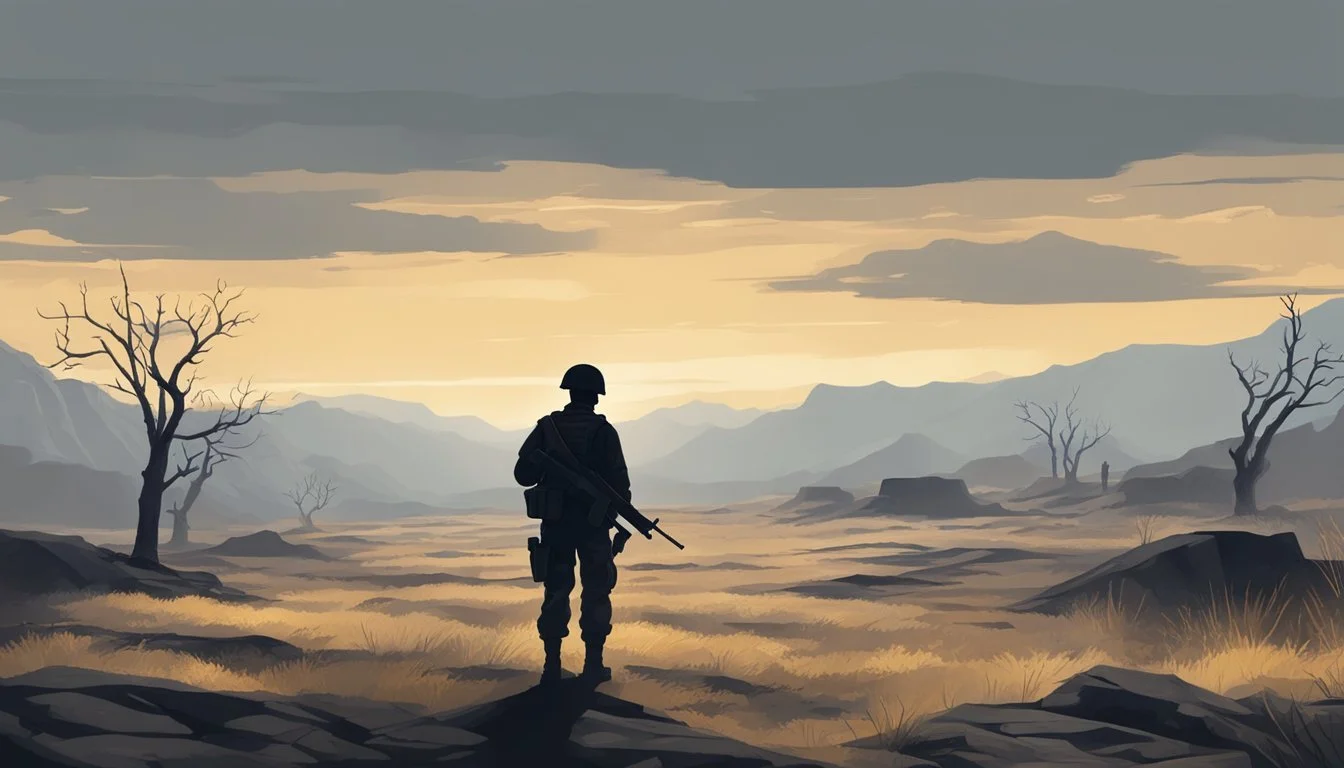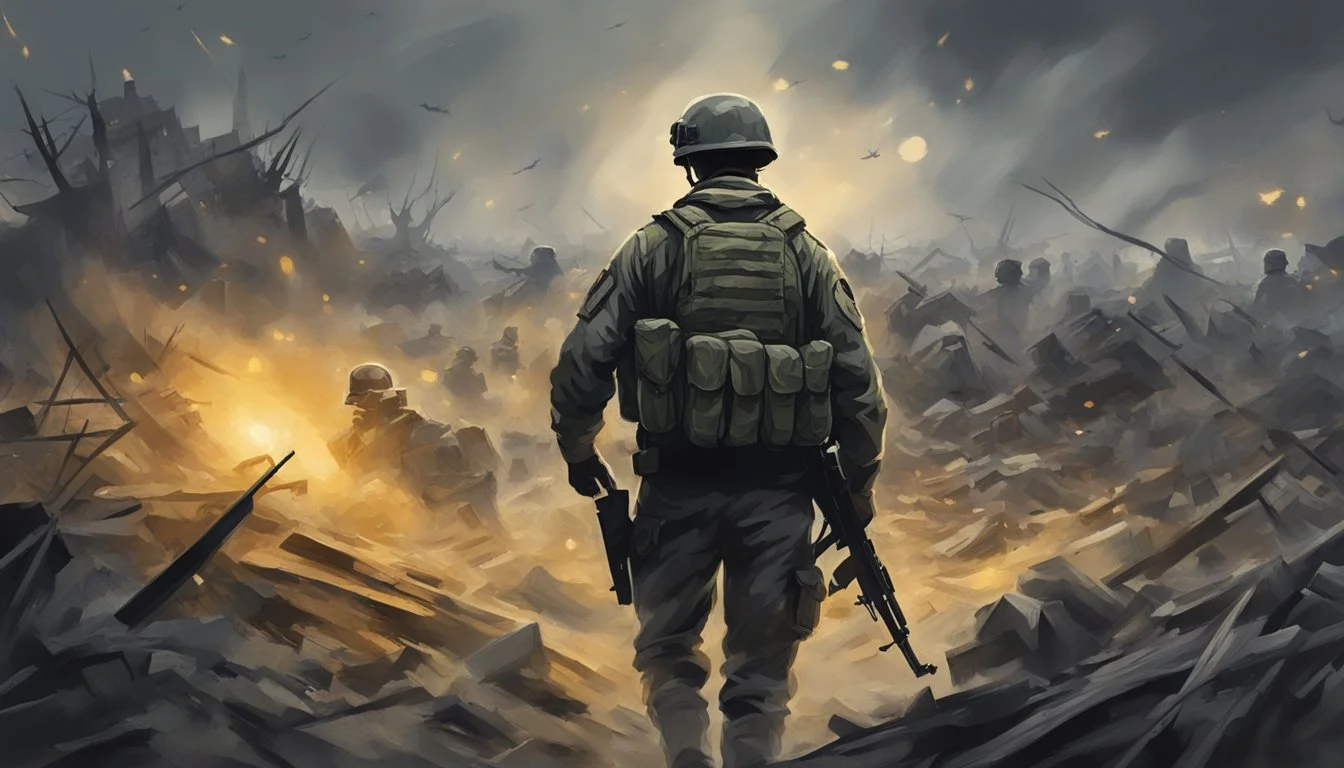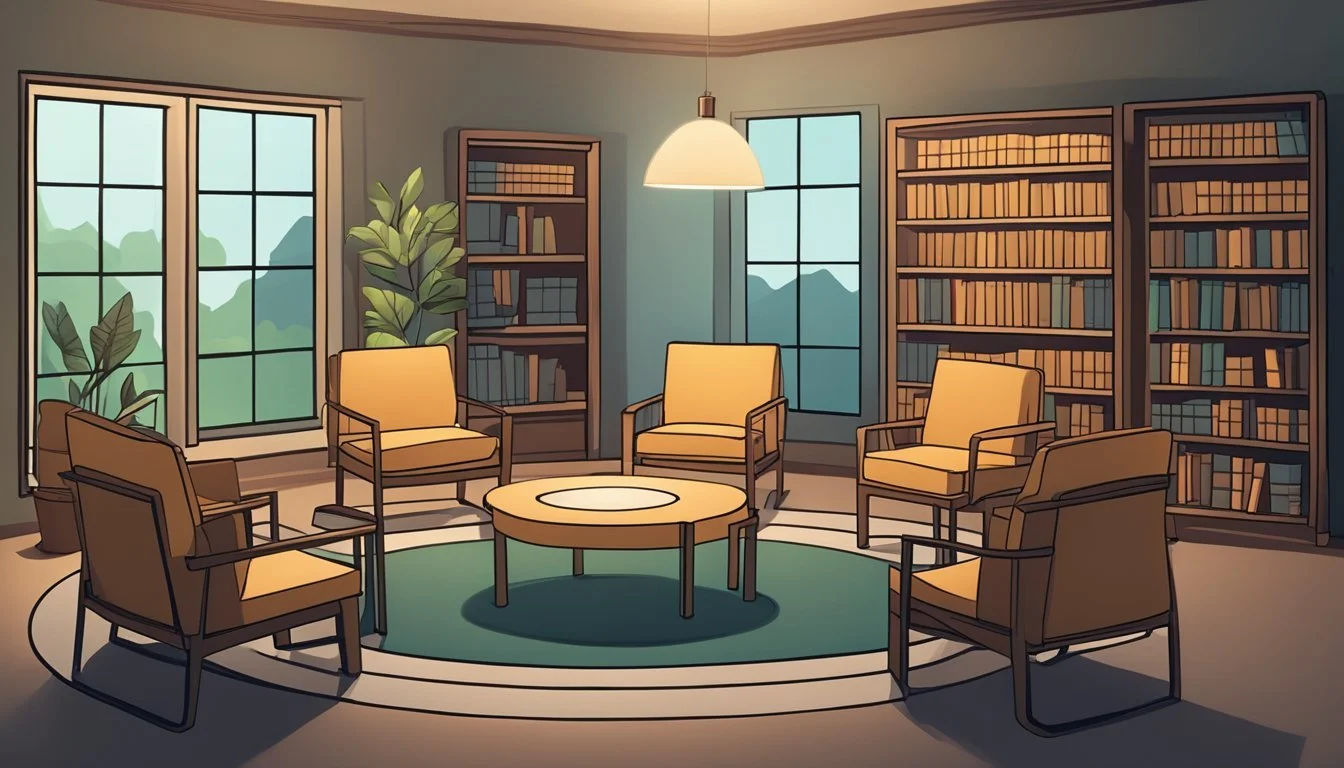Understanding Post-Traumatic Stress Disorder in World War 2 Veterans
World War II left deep psychological scars on many who experienced its horrors. Soldiers and civilians alike suffered from what we now recognize as post-traumatic stress disorder (PTSD). At the time, terms like "shell shock" and "war neuroses" were used to describe the mental health impacts of combat and wartime trauma.
The effects of World War II PTSD extended far beyond the immediate post-war years. Many veterans struggled with unprocessed trauma for decades, often only seeking help later in life. The 1990s saw a surge in World War II veterans seeking treatment for PTSD at VA centers, as aging and life changes brought suppressed memories to the surface.
The long-term impact of World War II trauma continues to affect families today. Research suggests that the psychological effects of war can be passed down through generations, influencing family dynamics and mental health outcomes for descendants of those who lived through the conflict. This underscores the enduring legacy of World War II and the importance of recognizing and addressing trauma's far-reaching consequences.
Historical Context of PTSD in World War II
World War II profoundly impacted the understanding and recognition of psychological trauma in combat veterans and survivors. The conflict's scale and intensity led to significant advancements in identifying and treating war-related mental health issues.
Terminology Evolution: From Shell Shock to PTSD
The term "shell shock" from World War I gave way to new labels during World War II. Doctors used "combat fatigue" and "war neurosis" to describe psychological reactions to battle stress. These terms reflected a growing awareness of the mental toll of warfare.
The U.S. Army introduced "psychiatric casualties" as an official category. This shift acknowledged that combat-related mental health issues were legitimate medical concerns.
After the war, researchers continued to study these conditions. Their work laid the groundwork for the formal recognition of Post-Traumatic Stress Disorder (PTSD) in 1980 when it was added to the DSM-III.
Combat and PTSD
World War II exposed millions of soldiers to prolonged periods of intense combat. Many experienced symptoms now associated with PTSD.
Common reactions included:
Flashbacks
Nightmares
Hypervigilance
Emotional numbness
The sheer scale of the war meant that a large number of veterans returned home with these invisible wounds. This prompted increased research and attention to combat-related mental health issues.
Military psychiatrists developed new treatment approaches during the war. They emphasized treating soldiers near the front lines and quickly returning them to duty when possible.
PTSD in Holocaust Survivors
Holocaust survivors experienced extreme trauma that had lasting psychological effects. Many struggled with:
Survivor's guilt
Chronic anxiety
Depression
Trust issues
The study of Holocaust survivors significantly contributed to the understanding of long-term trauma effects. It highlighted how severe, prolonged stress could lead to persistent psychological symptoms.
Researchers found that some survivors experienced delayed onset of PTSD symptoms, sometimes decades after the war. This insight expanded the understanding of trauma's long-term impact.
Differences in World War I and World War II Trauma
While both wars caused significant psychological trauma, World War II differed in several key aspects:
World War I World War II Trench warfare More mobile combat Limited civilian involvement Widespread civilian casualties Focus on "shell shock" Broader recognition of psychological effects
World War II's global nature meant more diverse trauma experiences. It included combat stress, prisoner of war experiences, and civilian trauma from bombings and occupation.
The Holocaust and atomic bombings introduced unprecedented forms of trauma. These events challenged existing concepts of war-related psychological injuries.
Clinical Understanding and Diagnosis
Post-traumatic stress disorder in World War II veterans emerged as a recognized condition over time. Its diagnosis framework, symptoms, and criteria evolved as medical understanding progressed.
Development of PTSD Diagnosis Framework
The concept of combat-related trauma existed before PTSD's official recognition. "Shell shock" in World War I and "combat fatigue" in World War II described similar symptoms.
The American Psychiatric Association introduced PTSD in the third edition of the Diagnostic and Statistical Manual of Mental Disorders (DSM-III) in 1980. This marked a shift in understanding trauma's psychological impact.
The DSM has undergone several revisions since then, refining PTSD diagnostic criteria. These updates reflect ongoing research and clinical observations of trauma survivors.
Symptoms and Diagnostic Criteria
PTSD symptoms fall into four main categories:
Intrusive thoughts (flashbacks, nightmares)
Avoidance of trauma-related stimuli
Negative changes in thoughts and mood
Changes in arousal and reactivity
Diagnosis requires:
Exposure to a traumatic event
Symptoms lasting over a month
Significant distress or functional impairment
Severity can range from mild to severe, impacting daily life and relationships. Symptoms may appear immediately or develop months or years after the traumatic event.
Combat-Related PTSD
Combat exposure poses unique risks for PTSD development. Factors include:
Prolonged periods of danger
Witnessing death or injury
Moral injury from wartime actions
World War II veterans often experienced delayed onset PTSD. Many coped silently for decades before seeking help.
Combat-related PTSD can manifest differently from civilian trauma. Heightened vigilance, difficulty reintegrating into civilian life, and survivor's guilt are common.
Treatment approaches for combat PTSD include:
Cognitive-behavioral therapy
Exposure therapy
Medication for symptom management
Early intervention and tailored treatment plans improve outcomes for veterans with PTSD.
Symptomatology
World War II veterans with PTSD experienced a range of cognitive, behavioral, emotional, and psychological symptoms that significantly impacted their daily lives and relationships.
Cognitive and Behavioral Impact
PTSD in WWII veterans manifested through various cognitive and behavioral symptoms. Many experienced intrusive thoughts and traumatic memories related to their wartime experiences. These often led to difficulty concentrating and memory problems. Hypervigilance was common, with veterans remaining constantly on alert for potential threats.
Avoidance behaviors were frequently observed. Veterans might avoid places, activities, or conversations that reminded them of the war. This could lead to social isolation and difficulties in maintaining relationships.
Sleep disturbances were prevalent. Nightmares and insomnia affected up to 80% of veterans with PTSD. These sleep issues often persisted for decades after the war, significantly impacting their quality of life.
Emotional and Psychological Effects
WWII veterans with PTSD often struggled with intense emotional and psychological symptoms. Anxiety was a core feature, with many experiencing persistent worry and fear. This anxiety could manifest as panic attacks or excessive nervousness in everyday situations.
Depression was common, characterized by feelings of sadness, hopelessness, and loss of interest in activities. Some veterans reported emotional numbness, finding it difficult to experience positive emotions or connect with others.
Irritability and anger outbursts were frequent complaints, affecting up to 65% of veterans. These mood changes could strain relationships with family and friends.
Flashbacks were a distressing symptom, causing veterans to vividly re-experience traumatic events. These intense, involuntary memories could be triggered by various stimuli, further reinforcing avoidance behaviors.
Treatment Approaches
Treatment for PTSD in World War II veterans evolved significantly over time. Various methods emerged to address the psychological trauma experienced by soldiers.
Early Interventions Post-World War II
Immediately after the war, doctors focused on rapid symptom relief. Some psychiatrists used sodium amytal, a barbiturate, to help veterans recall and process traumatic memories. This "truth serum" approach aimed to unlock repressed emotions.
Group therapy sessions became popular. Veterans shared experiences with peers who understood their struggles. Doctors encouraged patients to discuss their "nostalgia" - a term then used for combat stress reactions.
Rest and relaxation were prescribed as initial treatments. Extended hospital stays allowed veterans time to decompress from war experiences before reintegrating into civilian life.
Modern Psychotherapy Techniques
Cognitive-behavioral therapy (CBT) emerged as a leading treatment for PTSD. This approach helps veterans identify and change negative thought patterns related to their trauma.
Exposure therapy, a form of CBT, gradually exposes patients to trauma-related memories in a safe environment. This technique aims to reduce fear responses over time.
Eye Movement Desensitization and Reprocessing (EMDR) combines exposure therapy with guided eye movements. Some veterans find this method effective for processing traumatic memories.
Virtual reality programs now simulate combat scenarios. These tools allow veterans to confront triggers in a controlled setting with therapist guidance.
Pharmacotherapy and Medication
Selective serotonin reuptake inhibitors (SSRIs) are commonly prescribed for PTSD. These antidepressants can help reduce symptoms like anxiety, depression, and intrusive thoughts.
Prazosin, originally a blood pressure medication, has shown promise in reducing nightmares associated with PTSD.
Benzodiazepines are sometimes used for short-term anxiety relief. However, long-term use is generally avoided due to potential for dependence.
VA treatment centers now offer combination therapies. These integrate medication with psychotherapy for a comprehensive approach to mental health care.
Newer research explores alternative medications like ketamine and MDMA-assisted psychotherapy for treatment-resistant PTSD cases.
Societal and Cultural Impact
World War II's psychological toll extended far beyond individual survivors, profoundly shaping societies and cultures. The trauma experienced during the war influenced public attitudes, family dynamics, and support systems for decades to come.
Public Perception and Stigma
Post-traumatic stress in WWII veterans was often misunderstood or overlooked. Many survivors faced social stigma when seeking help. The public viewed combat-related psychological issues as weakness or cowardice.
This perception led many veterans to repress their experiences and emotions. They frequently turned to alcohol or isolation as coping mechanisms. The lack of open dialogue about war trauma hindered recovery efforts for countless individuals.
Intergenerational Trauma
The effects of WWII trauma rippled through generations. Children and grandchildren of survivors often inherited unresolved psychological burdens. This phenomenon, known as intergenerational trauma, manifested in various ways.
Offspring of traumatized individuals frequently reported:
Anxiety and depression
Difficulty forming attachments
Heightened sensitivity to stress
Unexplained fears or phobias
These symptoms persisted even in those born decades after the war's end. The transmission of trauma occurred through both direct communication and subtle behavioral patterns within families.
Social Acknowledgment and Support
As understanding of PTSD grew, societal attitudes began to shift. Veterans' support groups emerged, offering safe spaces for sharing experiences. Mental health professionals developed specialized treatments for war-related trauma.
Government initiatives improved access to care for aging WWII veterans. The 1990s saw an influx of survivors seeking treatment, often triggered by retirement or loss of a spouse.
Public recognition of war trauma's long-term impact increased. Memorial projects and oral history initiatives allowed survivors to share their stories. This acknowledgment played a crucial role in the healing process for many veterans and their families.
Personal Accounts and Narratives
World War II left deep psychological scars on those who experienced its horrors firsthand. Soldiers, civilians, and prisoners of war each faced unique challenges that shaped their memories and long-term mental health.
Soldiers' Experiences in Combat
Many veterans vividly recalled the intense fear and chaos of battle. A British fighter pilot described dogfights as "a bitter ballet of life and death in the skies." Infantry soldiers endured constant mortar fire and the ever-present threat of snipers. During the Battle of the Bulge, one American soldier recounted huddling in a foxhole for days, his only comfort a rosary clutched tightly in frozen fingers.
The sights and sounds of combat became seared into veterans' memories. The smell of burning flesh, the cries of wounded comrades, and the jarring explosions of artillery haunted many for decades after the war ended. Some developed severe anxiety or depression.
Civilians and Non-Combatants
Civilians in war-torn regions faced their own traumas. In the Netherlands, many endured near-starvation during the "Hunger Winter" of 1944-1945. One survivor recalled: "We ate tulip bulbs and sugar beets. I saw people collapse in the streets from hunger."
Air raids brought terror to cities across Europe. A London woman described huddling in a bomb shelter: "The walls shook. We never knew if the next one would hit us." The constant fear and loss of loved ones left lasting psychological scars on many non-combatants.
POWs and Their Long-Term Struggles
Prisoners of war often endured extreme deprivation and abuse. Many emerged from captivity with severe physical and mental health issues. A U.S. airman held in a German Stalag described constant hunger and bitter cold: "We were walking skeletons by the end."
Those in Japanese camps faced brutal treatment. One British POW recalled being forced to work on the Burma Railway: "Men died daily from exhaustion, disease, and beatings." Many developed severe PTSD and struggled to readjust to civilian life after liberation.
Concentration camp survivors carried particularly heavy burdens. The extreme trauma and loss they experienced often led to lifelong depression, anxiety, and difficulty forming relationships. Some battled guilt over surviving when so many others perished.
Legacy and Remembrance
World War II's impact continues to resonate decades later through memorials, education, and healing practices. These efforts help preserve the memories of those who served and suffered while fostering understanding across generations.
World War II Memorials and Remembrance Practices
Memorials like the one in Normandy serve as powerful reminders of the war's human cost. The American Cemetery overlooking Omaha Beach contains graves of nearly 10,000 soldiers. In Sainte-Mère-Église, a paratrooper mannequin hangs from the church tower, commemorating John Steele's landing during the D-Day invasion.
Annual ceremonies on June 6th draw veterans, families, and dignitaries to honor the fallen. These events often feature reenactments, with participants dressed as Allied soldiers landing on the beaches.
In Burma, the Thanbyuzayat War Cemetery memorializes prisoners of war who died building the Burma-Siam railway. These sites provide spaces for reflection and remembrance.
Educational Impact and The Importance of History
Museums and educational programs play a crucial role in preserving WWII history. The National WWII Museum in New Orleans offers interactive exhibits and oral histories from veterans like Roy 'Eric' Cooper, a British soldier who fought in the Burma campaign.
Films such as "The Longest Day" bring historical events to life for new generations. This 1962 epic portrays the D-Day landings, helping audiences visualize the scale and complexity of the operation.
School curricula increasingly emphasize WWII's global impact. Students learn about key battles, the Holocaust, and the war's lasting effects on geopolitics and society.
Personal and Collective Healing
For many veterans, sharing their experiences aids in personal healing. Oral history projects allow them to process traumatic memories while contributing to the historical record.
Support groups and therapy programs specifically tailored for aging WWII veterans address PTSD and other mental health issues. These interventions recognize that trauma can resurface later in life, especially as veterans face health challenges like pneumonia.
Recent research explores how wartime experiences affect brain function in older adults. This work aims to improve care for aging veterans and understand the long-term neurological impacts of combat stress.
Community events that bring together veterans, families, and younger generations foster collective healing. These gatherings promote understanding and bridge generational gaps, ensuring the lessons of WWII are not forgotten.
Contemporary Research and Findings
Recent studies have uncovered long-lasting impacts of World War II trauma on PTSD symptoms and cognitive functioning. Researchers continue to explore the complex interplay between historical factors, aging, and mental health outcomes in survivors.
Current Studies on World War II PTSD
A national study of Polish WWII survivors examined post-trauma adaptational styles and their relationship to current PTSD symptoms. Researchers identified three main styles: fighter, numb, and victim. The study found correlations between these adaptational styles and present-day PTSD manifestations.
Brain imaging studies have revealed structural and functional differences in WWII survivors with PTSD compared to those without the disorder. These neurobiological findings provide insights into the long-term effects of trauma on the brain.
Research has also explored the intersection of WWII trauma with other health conditions. Some studies suggest a potential link between PTSD and increased cancer risk in survivors, though more research is needed to establish a causal relationship.
Research Gaps and Future Directions
While significant progress has been made, several research gaps remain. Limited data exists on the experiences of certain survivor groups, such as those who endured sexual abuse during the war. More diverse and inclusive studies are needed to fully understand the range of WWII trauma impacts.
Longitudinal studies tracking PTSD symptoms over decades are scarce. Future research should focus on the trajectory of PTSD symptoms throughout the lifespan of survivors.
The interaction between WWII trauma and other forms of mental illness requires further investigation. Understanding these complex relationships could improve treatment approaches for aging survivors with multiple mental health concerns.
Resources and Support Systems
Veterans affected by World War II-related PTSD have access to various support networks and resources. These range from government-provided services to organizations dedicated to assisting veterans and their families.
Veteran Affairs and Support Organizations
The Department of Veterans Affairs (VA) offers comprehensive mental health services for World War II veterans struggling with PTSD. These include specialized PTSD treatment programs, counseling, and medication management. The VA also provides disability compensation for service-connected PTSD.
Veterans can access support through organizations like the Veterans of Foreign Wars (VFW) and the American Legion. These groups offer peer support networks, advocacy services, and assistance with VA claims.
Many communities have local veteran centers that provide counseling and support groups specifically for World War II veterans dealing with PTSD.
Resources for Families and Caregivers
Family members and caregivers of World War II veterans with PTSD can find support through various channels. The VA offers caregiver support services, including education, counseling, and respite care.
Organizations like the National Alliance on Mental Illness (NAMI) provide educational resources and support groups for families dealing with PTSD.
Online forums and support groups connect caregivers with others facing similar challenges. These platforms offer a space to share experiences and coping strategies.
Books and educational materials about PTSD in World War II veterans can help families better understand and support their loved ones.







